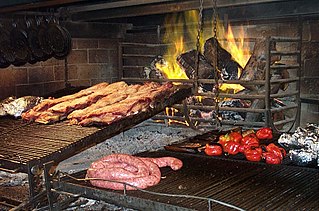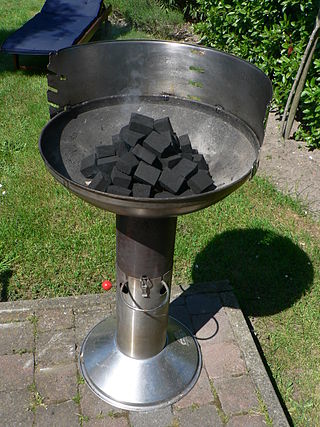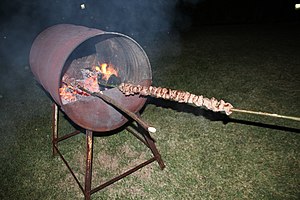
Turkish cuisine is the cuisine of Turkey and the Turkish diaspora. Although the cuisine took its current rich form after numerous cultural interactions throughout centuries, it should not be confused with other cuisines such as Ottoman cuisine or Seljuk cuisine. Turkish cuisine with traditional Turkic elements such as yogurt, ayran, kaymak, exerts and gains influences to and from Mediterranean, Balkan, Middle Eastern, Central Asian and Eastern European cuisines.

Satay, or sate in Indonesian spelling, is a Southeast Asian form of kebab made from seasoned, skewered and barbecued meat, served with a sauce.

A skewer is a thin metal or wood stick used to hold pieces of food together. The word may sometimes be used as a metonym, to refer to the entire food item served on a skewer, as in "chicken skewers". Skewers are used while grilling or roasting meats and fish, and in other culinary applications.

Offal, also called variety meats, pluck or organ meats, is the internal organs of a butchered animal. The word does not refer to a particular list of edible organs, and these lists of organs vary with culture and region, but usually exclude skeletal muscle. Offal may also refer to the by-products of milled grains, such as corn or wheat.

Kebab, kabob, kebap, or kabab is roasted meat that originates from the Middle East. Many variants of the category are popular around the world, including the skewered shish kebab and the doner kebab with bread.

Bulgogi, literally "fire meat") is a gui made of thin, marinated slices of meat, most commonly beef, grilled on a barbecue or on a stove-top griddle. It is also often stir-fried in a pan in home cooking. Sirloin and rib eye are frequently used cuts of beef for the dish. The dish originated from northern areas of the Korean Peninsula, but is a very popular dish in South Korea, where it can be found anywhere from upscale restaurants to local supermarkets as pan-ready kits.

Asado is the technique and the social event of having or attending a barbecue in various South American countries: especially Argentina, Chile, Paraguay, Peru, and Uruguay where it is also a traditional event. An asado usually consists of beef, pork, chicken, chorizo, and morcilla; all of which are cooked using an open fire or a grill, called a parrilla. Usually, red wine and side dishes such as salads accompany the main meats, which are prepared by a designated cook called the asador or parrillero.

Churrasco is the Portuguese and Spanish name for grilled beef prominent in the cuisines of Brazil, Colombia, Uruguay, and Argentina. The term is used in other Spanish- and Portuguese-speaking countries for a variety of different meat products.

Anticuchos are popular and inexpensive meat dishes that originated in the Andes during the pre-Colombian era, specifically in the Antisuyu region of the Tawantinsuyu. The modern dish was adapted during the colonial era between the 16th and 19th centuries and can now be found in Peru, Bolivia, and Ecuador, where they are known as "chuzos" or "carne en palito".

Barbecue varies by the type of meat, sauce, rub, or other flavorings used, the point in barbecuing at which they are added, the role smoke plays, the equipment and fuel used, cooking temperature, and cooking time.

Pinchitos or pinchos morunos is a Moorish-derived food in Spanish cuisine, similar to kebab. The name pinchitos is used in the southern Spanish autonomous communities of Andalusia and Extremadura. They consist of small cubes of meat threaded onto a skewer which are traditionally cooked over charcoal braziers.

Kyrgyz cuisine is the cuisine of the Kyrgyz, who comprise a majority of the population of Kyrgyzstan. The cuisine is similar in many aspects to that of their neighbors.

Barbecue chicken consists of chicken parts or entire chickens that are barbecued, grilled or smoked. There are many global and regional preparation techniques and cooking styles. Barbecue chicken is often seasoned or coated in a spice rub, barbecue sauce, or both. Marinades are also used to tenderize the meat and add flavor. Rotisserie chicken has gained prominence and popularity in U.S. grocery markets. Barbecued chicken is one of the world's most popular barbecue dishes.

Inihaw, also known as sinugba or inasal, are various types of grilled or pit-roasted barbecue dishes from the Philippines. They are usually made from pork or chicken and are served on bamboo skewers or in small cubes with a soy sauce and vinegar-based dip. The term can also refer to any meat or seafood dish cooked and served in a similar way. Inihaw are commonly sold as street food and are eaten with white rice or rice cooked in coconut leaves (pusô). Inihaw is also commonly referred to as Filipino barbecue or (informally) Pinoy BBQ.

Venetian cuisine, from the city of Venice, Italy, or more widely from the region of Veneto, has a centuries-long history and differs significantly from other cuisines of northern Italy, and of neighbouring Austria and of Slavic countries, despite sharing some commonalities.

Meat plays a much more dominant role in Pakistani cuisine, compared to other South Asian cuisines. Of all the meats, the most popular are chicken, lamb, beef, goat, and fish.Beef is particularly sought after as the meat of choice for kebab dishes or the classic beef shank dish nihari. Seafood is generally not consumed in large amounts, though it is very popular in the coastal areas of Sindh and the Makran coast of Balochistan.





















